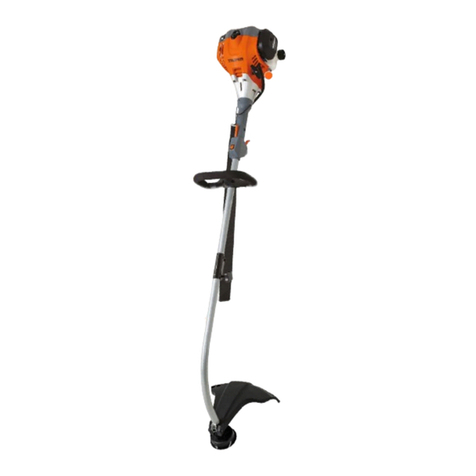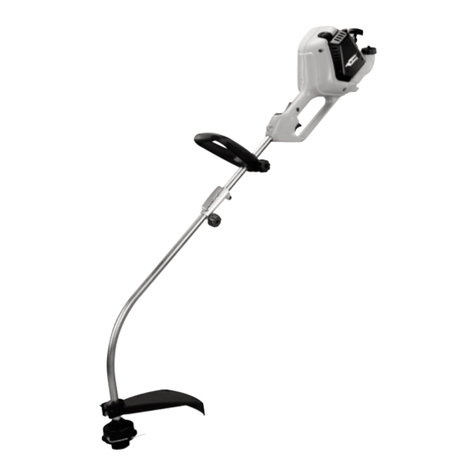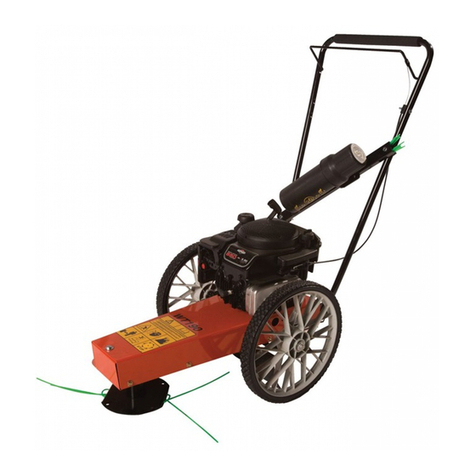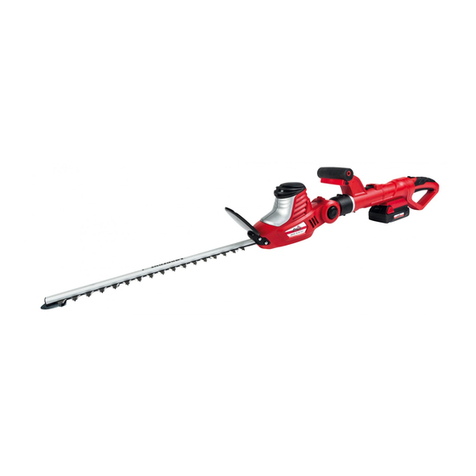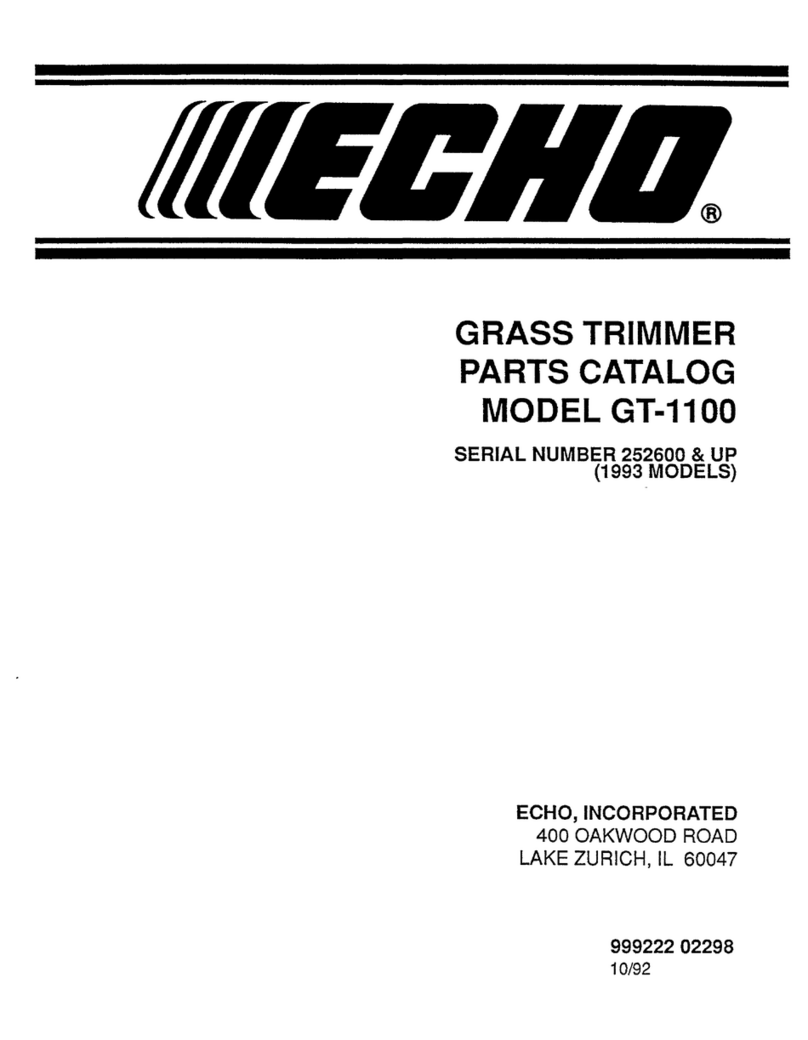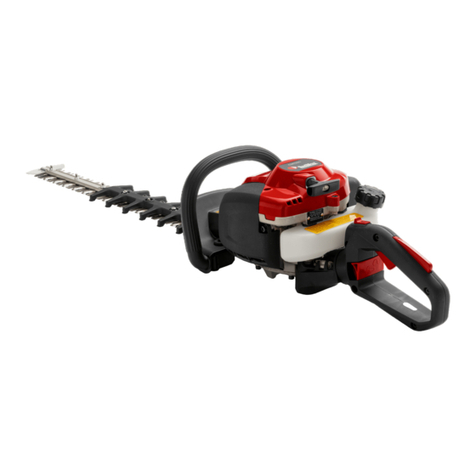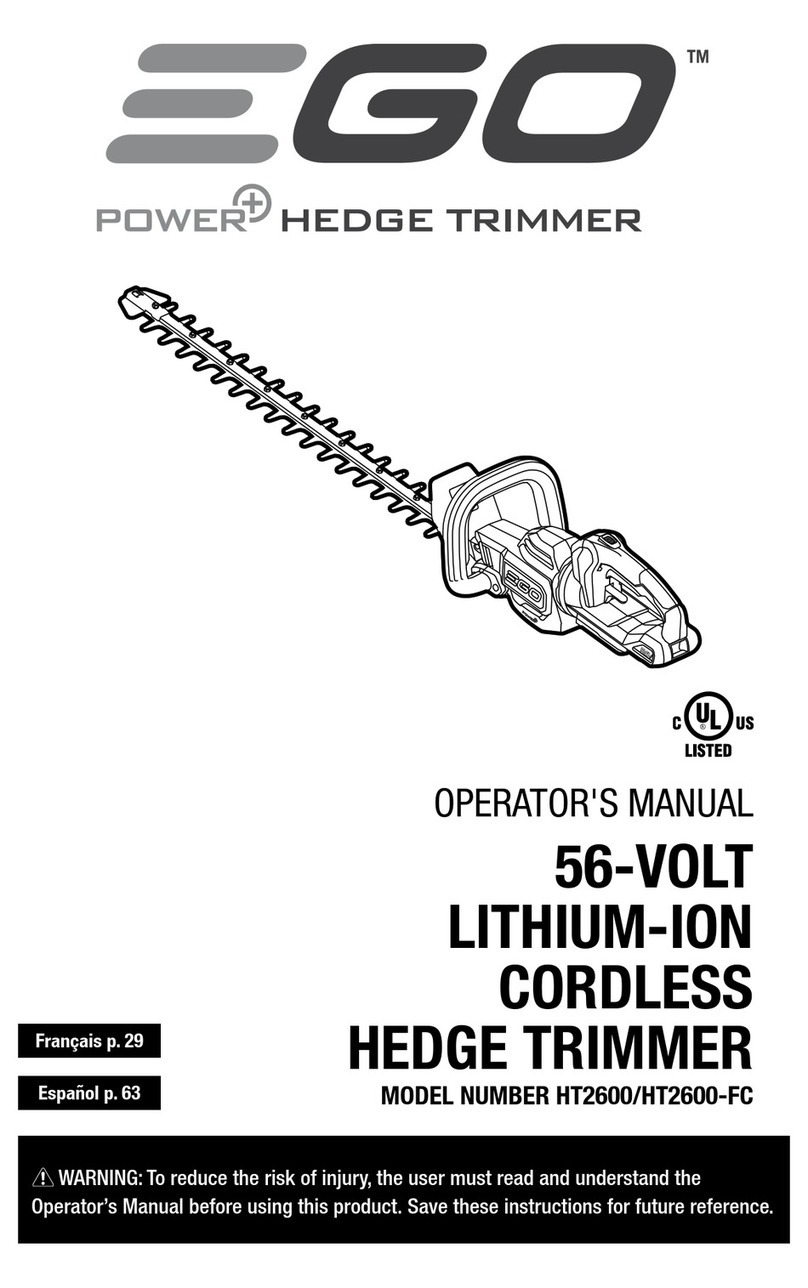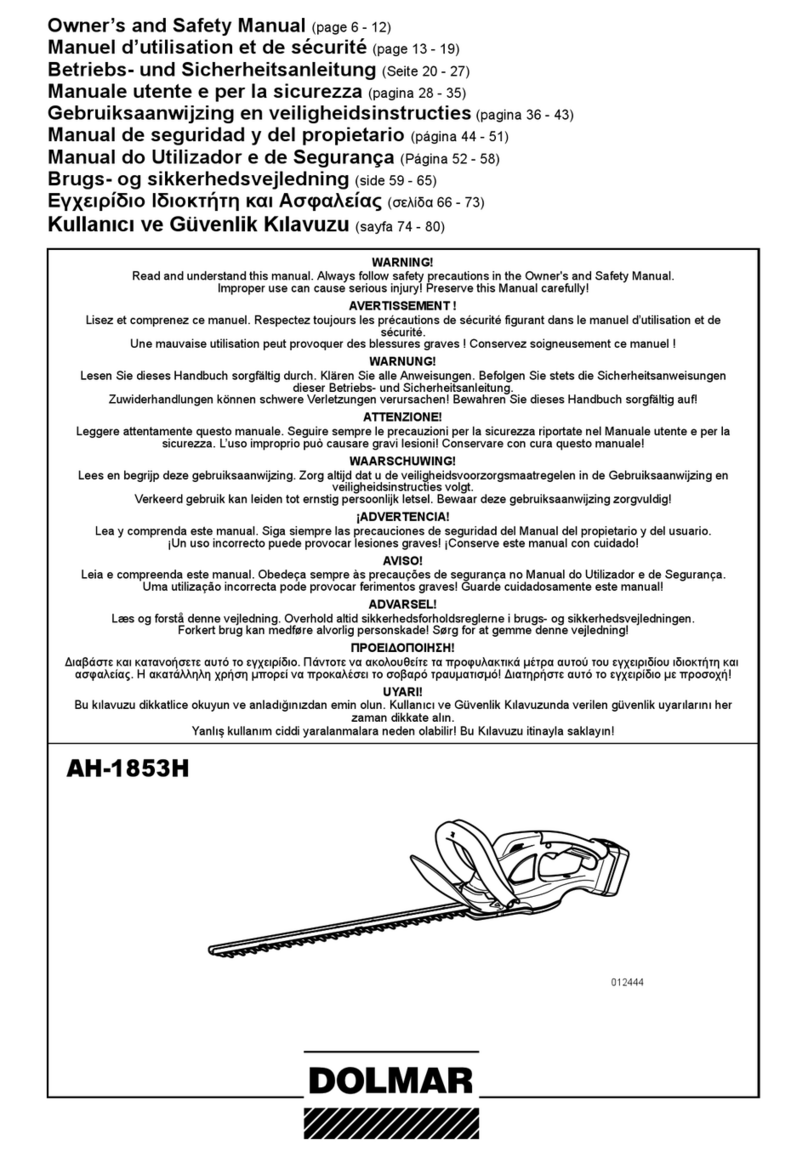Truper DES-1000 User manual

DES-1000
Modelo Código
DES-1000
Este instructivo es para:
13521
Potencia
1 000 W
Lea este instructivo por completo
antes de usar la herramienta.
ATENCIÓN
ESPAÑOL
ENGLISH
Instructivo de
Desbrozadora
/ Orilladora

Í
ndice
2
Especificaciones técnicas
Requerimientos eléctricos
Advertencias de Seguridad
para herramientas eléctricas
Advertencias de Seguridad
para uso de desbrozadoras eléctricas
Partes
Montaje
Puesta en marcha
Mantenimiento
Solución de problemas
Centros de Servicio Autorizados
Sucursales
Póliza de Garantía
3
3
4
5
6
6
8
9
9
10
12
12
DES-1000
Guarde este instructivo para futuras referencias.
Los gráficos de este instructivo son para
referencia, pueden variar del aspecto real de la
herramienta.
Para poder sacar el máximo
provecho de la herramienta,
alargar su vida útil, hacer válida
la garantía en caso de ser
necesario y evitar riesgos o
lesiones graves, es fundamental
leer este instructivo por
completo antes de usar la
herramienta.
ATENCIÓN
ESPAÑOL

Requerimientos eléctricos
3
DES-1000
13521
60 Hz
Desbrozadora y Orilladora
18 AWG x 2C con temperatura de aislamiento de 90 °C
8 A
1 000 W
Código
Descripción
Tensión
Frecuencia
Corriente
Potencia
7500 r/min
Velocidad
350 mm (14”)
1,6 mm
Capacidad de corte
Diámetro de hilo de corte
50 minutos de trabajo por 20 minutos de descanso. Máximo 6 horas diarias.
Ciclo de trabajo
Conductores
El cable de alimentación tiene sujeta-cables tipo: Y
La clase de construcción de la herramienta es: aislamiento reforzado.
La clase de aislamiento térmico de los devanados del motor: Clase E
127 V
Especificaciones técnicas
de 0 A hasta 10 A
de 10 A hasta 13 A
de 13 A hasta 15 A
de 15 A hasta 20 A
18 AWG(*)
16 AWG
14 AWG
8 AWG
16 AWG
14 AWG
12 AWG
6 AWG
3 (uno a tierra)
de 1,8 m a 15 m | mayor de 15 m
Capacidad en
Amperes Número de
conductores Calibre de extensión
*Se permite utilizarlo siempre y cuando las extensiones mismas cuenten con un artefacto de protección contra sobrecorriente.
AWG = Calibre de alambre estadounidense (American Wire Gauge). Referencia: NMX-J-195-ANCE
Las herramientas de doble aislamiento y aislamiento reforzado
están equipadas con una clavija polarizada (una pata es más ancha que la otra). Esta
clavija cabe en cualquier enchufe polarizado y sólo puede conectarse de una forma. Si la
clavija no cabe en el enchufe, voltéelo. Si aún así no cabe, póngase en contacto con un
electricista calificado o instale un enchufe polarizado. No altere la clavija en forma alguna.
Ambos tipos de aislamiento eliminan la necesidad de un cable de corriente de tres partes
con conexión a tierra o de un sistema de corriente eléctrica con conexión a tierra.
Al usar un cable de extensión, asegúrese de usar el calibre
suficiente para transportar la corriente que consumirá su herramienta. Un cable de un calibre inferior ocasionará caídas de
tensión en la línea, teniendo como resultado pérdida de potencia y sobrecalentamiento del motor. La siguiente tabla muestra el
tamaño correcto que debe usarse dependiendo de la longitud del cable y de la capacidad de amperes indicada en la placa de
datos de la herramienta. Si tiene dudas use el siguiente calibre más alto.
Si el cable de alimentación se daña, éste debe ser reemplazado por el fabricante o Centro de Servicio
Autorizado , con el fin de evitar algún riesgo de descarga o accidente considerable.
La construcción del aislamiento eléctrico de esta herramienta es alterado por salpicaduras o derramamiento
de líquidos durante su operación. No la exponga a la lluvia, líquidos y/o humedad.
Antes de obtener acceso a las terminales, todos los circuitos de alimentación deben ser desconectados.
ADVERTENCIA
ADVERTENCIA
ADVERTENCIA
ADVERTENCIA
ADVERTENCIA Al operar herramientas eléctricas en exteriores, utilice una extensión
aterrizada marcada como “Uso exterior” marca . Estas extensiones son
especiales para el uso en exteriores y reducen el riesgo de sufrir una descarga eléctrica. ESPAÑOL
Clase II
Aislamiento IP20
Grado IP
Antes de utilizar el cordón de alimentación o algún cordón flexible adicional verificar que éstos no presenten señales de daño
o maltratado. Si el cordón se llega a dañar durante su uso, desconectar el cordón de la alimentación inmediatamente. NO
TOCAR EL CORDÓN DE ALIMENTACIÓN ANTES DE DESCONECTAR DE LA ALIMENTACIÓN . NO utilice el aparato si el cordón
de alimentación esta dañado o maltratado.

4
Advertencias generales de seguridad
para herramientas eléctricas
Esta herramienta cumple con la
Norma Oficial Mexicana (NOM).
Área de trabajo
Mantenga el área de trabajo limpia y bien iluminada.
Las áreas desordenadas y obscuras son propensas a accidentes.
No maneje la herramienta en ambientes explosivos, como en
presencia de líquido, gas o polvo inflamables.
Las herramientas eléctricas producen chispas que pueden encender
material inflamable.
Mantenga alejados a los niños y curiosos cuando opere la
herramienta.
Las distracciones pueden hacer que pierda el control.
Seguridad eléctrica
La clavija de la herramienta debe coincidir con el tomacorrien-
te. Nunca modifique una clavija. No use ningún tipo de
adaptador para clavijas de herramientas puestas a tierra.
Clavijas modificadas y enchufes diferentes aumentan el riesgo de
choque eléctrico.
Evite el contacto del cuerpo con superficies puestas a tierra
como tuberías, radiadores, cocinas eléctricas y refrigeradores.
Hay un mayor riesgo de choque eléctrico si el cuerpo está puesto a tierra.
No exponga la herramienta a la lluvia o condiciones de humedad.
El agua que ingresa en la herramienta aumenta el riesgo de choque eléctrico.
No fuerce el cable. Nunca use el cable para transportar,
levantar o desconectar la herramienta. Mantenga el cable
lejos del calor, aceite, orillas afiladas o piezas en movimiento.
Los cables dañados o enredados aumentan el riesgo de choque eléctrico.
Cuando maneje una herramienta en exteriores, use una
extensión especial para uso en exteriores.
El uso de una extensión adecuada para exteriores reduce el riesgo de choque
eléctrico.
Si el uso de la herramienta en un lugar húmedo es inevitable,
use una alimentación protegida por un interruptor de circuito
de falla a tierra (GFCI).
El uso de un GFCI reduce el riesgo de choque eléctrico.
Seguridad personal
Esté alerta, vigile lo que está haciendo y use el sentido común
cuando maneje una herramienta. No la use si está cansado o
bajo la influencia de drogas, alcohol o medicamentos.
Un momento de distracción mientras maneja la herramienta puede
causar un daño personal.
Use equipo de seguridad. Use siempre protección para los ojos.
El uso de equipo de seguridad como lentes de seguridad, mascarilla antipolvo,
zapatos antideslizantes, casco y protección para los oídos en condiciones
apropiadas, reduce de manera significativa los daños personales.
Evite arranques accidentales. Asegúrese de que el interruptor
está en posición “apagado” antes de conectar a la fuente de
alimentación y/o a la batería o transportar la herramienta.
Transportar herramientas eléctricas con el dedo sobre el interruptor o
conectar herramientas eléctricas que tienen el interruptor en posición de
“encendido” puede causar accidentes.
Retire cualquier llave o herramienta de ajuste antes de arrancar
la herramienta eléctrica.
Las llaves o herramientas que quedan en las partes rotativas de la
herramienta pueden causar un daño personal.
No sobrepase su campo de acción. Mantenga ambos pies bien
asentados sobre el suelo y conserve el equilibrio en todo
momento.
Esto permite un mejor control de la herramienta en situaciones inesperadas.
Vista adecuadamente. No vista ropa suelta o joyas. Mantenga su
pelo, su ropa y guantes alejados de las piezas en movimiento.
La ropa o el pelo sueltos o las joyas pueden quedar atrapados en
las piezas en movimiento.
En caso de contar con dispositivos de extracción y recolección
de polvo conectados a la herramienta, verifique sus conexiones
y úselos correctamente.
El uso de estos dispositivos reduce los riesgos relacionados con el polvo.
Uso y cuidados de la herramienta
No fuerce la herramienta. Use la herramienta adecuada para el
trabajo a realizar.
La herramienta adecuada hace un trabajo mejor y más seguro cuando
se usa al ritmo para el que fue diseñado.
No use la herramienta si el interruptor no funciona.
Cualquier herramienta eléctrica que no pueda encenderse o
apagarse es peligrosa y debe repararse antes de ser operada.
Desconecte la herramienta de la fuente de alimentación y/o de
la batería antes de efectuar cualquier ajuste, cambiar accesorios
o almacenarla.
Estas medidas reducen el riesgo de arrancar la herramienta accidentalmente.
Almacene las herramientas fuera del alcance de los niños y no
permita su manejo por personas no familiarizadas con las
herramientas o con las instrucciones.
Las herramientas eléctricas son peligrosas en manos no entrenadas.
Déle mantenimiento a la herramienta. Compruebe que las
partes móviles no estén desalineadas o trabadas, que no
haya piezas rotas u otras condiciones que puedan afectar su
operación. Repare cualquier daño antes de usar la herramienta.
Muchos accidentes son causados por el escaso mantenimiento de las
herramientas.
Mantenga los accesorios de corte afilados y limpios.
Los accesorios de corte en buenas condiciones son menos probables de
trabarse y más fáciles de controlar.
Use la herramienta, sus componentes y accesorios de acuerdo
con estas instrucciones y de la manera prevista para el tipo de
herramienta, en condiciones de trabajo adecuadas.
El uso de la herramienta para aplicaciones diferentes para las que
está diseñada podría causar una situación de peligro.
Servicio
Repare la herramienta en un Centro de Servicio Autorizado
usando sólo piezas de repuesto idénticas.
Para mantener la seguridad de la herramienta.
La máquina no debe de ser utilizada por niños ni por personas
con capacidades físicas, sensoriales o mentales reducidas;
tampoco por personas sin experiencia o conocimientos en su
uso, a menos que estén supervisadas por una persona
responsable de su seguridad o reciban instrucciones previas
sobre el uso de la máquina.
Los niños deben de estar bajo supervisión para asegurarse de que no jueguen
con la máquina. Se debe de mantener una estricta supervisión si niños o
personas discapacitadas llegan a utilizar cualquier tipo de aparato
electrodoméstico o estén cerca de él.
¡ADVERTENCIA! Lea detenidamente todas las advertencias de seguridad y todas las instrucciones que se enlistan a continuación. La omisión de
alguna de ellas puede dar como resultado un choque eléctrico, incendio y/o daño serio. Conserve las advertencias y las instrucciones para futuras referencias.
ESPAÑOL

5
Advertencias de Seguridad
para uso de desbrozadoras eléctricas
ESPAÑOL
ATENCIÓN
Antes de utilizar la desbrozadora
• Se recomienda que la desbrozadora
este conectada por medio de un dispositivo de corriente
residual (RCD) con una corriente de corte no mayor
que 30 mA.
• Lea las instrucciones cuidadosamente. Familiarícese con
los controles y el uso apropiado del equipo.
• Mantenga el cordón flexible adicional alejado de los
elementos de corte.
• Utilice protección para los ojos.
• Nunca permita que los niños o personas no
familiarizadas con el aparato lo utilicen.
• Evite el uso del aparato, mientras exista gente alrededor,
especialmente niños o mascotas.
• Utilice el aparato únicamente a la luz del día o cuando
exista una buena iluminación.
• Nunca opere el aparato con alguna guarda o protección
dañada, o sin guardas y protecciones en su lugar.
•Encienda el motor solo cuando las manos y los pies se
encuentren alejados de los elementos de corte.
• Nunca ensamble elementos de corte de metal.
• Utilice solamente las partes y accesorios de reemplazo
recomendados por el fabricante.
• Siempre desconecte el aparato de la alimentación
cuando no se utilice.
• Desconecte el aparato de la alimentación antes de llevar
a cabo el mantenimiento o limpieza.
• Inspeccione y brinde regularmente un mantenimiento al
aparato. El equipo solo debe repararse en un centro de
servicio autorizado.
• Tenga cuidado de no lastimarse con las navajas que
sirven para ajustar la longitud de los filamentos. Después
de colocar un nuevo filamento de corte, vuelva a colocar
el aparato a su posición normal de uso antes de
encenderlo nuevamente.
• Asegúrese siempre de que los orificios de ventilación
estén libre de residuos.
• Cuando no utilice el aparato manténgalo lejos de
alcance de los infantes.
• Inspeccione detenidamente el área que se va a recortar
para evitar cualquier obstáculo y retirar objetos extraños
que puedan ser lanzados por la desbrozadora. De lo
contrario puede provocar un accidente y reducir la vida
útil de la herramienta.
• El área que se va a recortar debe de
estar perfectamente iluminada.
• Asegúrese de que la desbrozadora
cuenta con todas sus partes en óptimo estado y tenga la
guarda del hilo de corte debidamente colocada. Revise
que las ranuras de ventilación estén libres de desechos.
No use la desbrozadora si la guarda está dañada o no
cuenta con todas sus partes.
• Utilice únicamente hilo de nailon
original, y por ningún motivo reemplazarlo por hilo de
metal.
• Para mejores resultados se recomienda utilizar sólo
reemplazos de hilo originales tales como: HTA-65B,
HIDE-65P,HTA-65 y HDU-15-65 marca Truper®.
• Recuerde que esta herramienta está diseñada para
cortar césped como se indica en este instructivo. De
ninguna manera se debe emplear para cualquier otro
propósito.
• Para evitar descargas eléctricas
evite realizar trabajos en ambientes húmedos, mientras
llueva y/o cortar césped con rocío.
Después de utilizar la desbrozadora
• Los elementos de corte
continúan girando después de apagar el motor.
• No intente detener el movimiento giratorio del hilo de
corte de ninguna otra forma que soltando el interruptor.
Espere a que el carrete se detenga por sí mismo después
de apagar la desbrozadora, esto demorará unos cuantos
segundos.
ADVERTENCIA
Mientras utiliza la desbrozadora
• No utilice la desbrozadora cerca de
otras personas, niños o animales.
• Nunca permita que el cabezal
de corte sobrepase los 30 cm de altura y no lo dirija a
personas o animales.
• Utilice la desbrozadora para
cortar únicamente a nivel del piso, por ningún motivo la
utilice para cortar vegetación sobre piedras o paredes.
• No camine por suelos de graba con
la desbrozadora funcionando, el hilo de corte puede
lanzar fragmentos de graba al operador u otras personas
provocando lesiones.
• Mantenga siempre a la vista el cable
de alimentación para evitar dañarlo con el hilo de corte.
• No acerque las manos o los
pies al cabezal de corte mientras la desbrozadora está
funcionando.
• En caso de realizar trabajos cerca de
vías de tránsito suspenda el corte hasta que no haya
vehículos a la vista. Ya que las partículas extrañas que
pueden ser lanzadas por la desbrozadora hacia los
vehículos en movimiento pueden desencadenar un
accidente grave.
ATENCIÓN
ATENCIÓN
ATENCIÓN
ADVERTENCIA
ADVERTENCIA
ADVERTENCIA
PELIGRO
ATENCIÓN
ATENCIÓN
ADVERTENCIA
ADVERTENCIA

1 32
Eje superior
6
Montaje
Partes
A
B
E
D
C
Eje curvo
• Inserte el eje curvo (A) en la montura (B) haciendo coincidir el
orificio (C) de la montura con el botón del eje curvo.
• Asegúrese de que la flecha flexible del eje curvo se acople
correctamente en el interior del adaptador (D) del mango superior.
• Apriete la perilla (E) para bloquear el eje curvo en su lugar.
Mango auxiliar tipo “D”
• Instale el mango auxiliar como se muestra en la imagen.
• Recorra el mango auxiliar por el eje superior a una altura adecuada para operar la
desbrozadora.
• Apriete la perilla para fijar la posición y el ángulo del mango auxiliar.
ESPAÑOL
Sujetador
del cable
Cable de
alimentación
Cabezal
de corte
Gatillo
interruptor
Hilo de
corte
Eje
superior
Guarda
protectora
Mango
Seguro del
interruptor
Mango
auxiliar
tipo “D”
Eje
curvo
Alerta de seguridad.
Lea el instructivo de uso antes de operar
la máquina.
Use protección auditiva.
Use lentes de seguridad.
No se deje al alcance de los niños.
No se exponga a la humedad.
Despejar el área donde vaya a cortarse
el césped de objetos que puedan salir
lanzados. Se deben mantener alejados
del área de corte a personas y animales.
En caso de dañarse el cable de
alimentación desconecte
inmediatamente la clavija.

1 2
Guarda
• Instale la guarda como se muestra en la imagen.
• Recuerde instalar debidamente la guarda antes de encender la desbrozadora.
Carrete de hilo de corte
• Con la desbrozadora apagada y desconectada retire la
tapa de retención del carrete (F) girándola en sentido
contrario a las manecillas del reloj.
• Retire el carrete vacío, asegúrese de que esté limpio y
que no tenga partes dañadas o gastadas.
• Corte una pieza de hilo de 3 m
• Doble el hilo a la mitad de su longitud, e insértelo en la
muesca.
• Tome ambos hilos y enrédelos en el sentido que indica la
flecha marcada en el carrete. Asegúrese de que cada pieza de
hilo se enrede en su sección respectiva (superior e inferior).
No enrede demasiado hilo, después de enredarlo debe
quedar una distancia mínima de 6 mm entre el borde del
carrete y el hilo enredado.
• Deje sin enredar aproximadamente 15 cm (6”) de ambos
hilos e inserte el hilo de la sección superior en una de las
muescas de la cubierta del carrete. Dé media vuelta más al
carrete e inserte el hilo de la sección inferior en la ranura
contraria de la cubierta del carrete.
Esto es con el fin de que el hilo no se desenrede mientras
instala el carrete en la desbrozadora, más adelante deberá
liberar los hilos de sus muescas.
• Coloque de nuevo el carrete en su cubierta (H) haciendo
pasar los extremos de cada hilo por los orificios de la
cubierta. Si el hilo se suelta o enreda en este paso vuelva a
enredarlo en el carrete y asegúrelo en sus muescas.
• Jale hacia afuera y con fuerza ambos extremos del hilo
de corte para liberarlo de las muescas de la parte superior
del carrete.
• Coloque el carrete con su cubierta en el eje de impulsión
(I) empuje el carrete hacia el eje para que sobresalga su
extremo roscado y asegúrelo con la tapa de retención (F).
• En el caso de instalar un carrete nuevo libere las puntas de
los hilos de sus muescas y desenrede 15 cm (6”) de ambos
hilos aproximadamente para volver a asegurarlos en sus
muescas antes de colocar el carrete en su cubierta.
• Se recomienda utilizar con hilos de corte de 1,6 mm de
diámetro modelo ( HDU-15-65, HTA-65 , HTA-65B,
HIDE-65P ) 7
Montaje
Tenga cuidado de no tocar
el filo de la cuchilla para
cortar el hilo de corte.
ESPAÑOL
Orificio de
la cubierta (x2)
Liberación de
las muescas
Muesca
F
I
H
G

30°
• Haga un bucle (A) en el extremo de una extensión aterrizada marcada como “Uso exterior” marca
y sujete a través del sujetador como se muestra en la imagen (B).
• Conecte la desbrozadora a la extensión como se indica en el gráfico.
• Estire perfectamente el cable de extensión para evitar obstáculos.
• Conecte la extensión a una toma de corriente que tenga
la tensión especificada para la desbrozadora.
• Como medida adicional de seguridad se recomienda
utilizar un interruptor de corriente (no incluido) en caso
de picos de corriente de 30 mA o menos.
• Para encender la desbrozadora presione el seguro del
interruptor (C) junto con el interruptor (D). El seguro del
interruptor evita encendidos accidentales.
• Para apagarla suelte el interruptor.
Movimiento
de corte
Rotación de
la cintura
8
Encendido
Puesta en marcha
Operación
• Recuerde que usted como operador
de la desbrozadora es responsable de su seguridad, así
como de quienes se encuentren cerca del área de trabajo.
Siga todas las normas de seguridad (páginas 4 y 5) antes
de operar la herramienta.
• Mantenga una postura equilibrada con ambos pies
apoyados firmemente en el piso.
• Sostenga la desbrozadora con firmeza frente a usted con
una mano en el mango y la otra en el mango auxiliar de
manera que la herramienta quede alineada a su cuerpo y
apuntando el cabezal de corte 30° hacia abajo, lejos de
sus pies.
• No encienda ni opere la desbrozadora
en cualquier otra posición.
• Encienda la desbrozadora y realice los cortes de
izquierda a derecha rotando su cintura manteniendo la
posición de la herramienta.
• Conforme se realice el corte de pasto el hilo de corte se
desgastará y terminará por desprenderse, para liberar más
hilo del carrete presione un poco la desbrozadora hacia
abajo para que el suelo presione la tapa de retención
contra el carrete y libere más hilo. El sobrante será cortado
por la cuchilla de la guarda, en ese instante deje de
empujar la desbrozadora contra el piso para no gastar hilo.
• Para cortar maleza o pasto altos hágalo gradualmente,
no intente cortarlo de una sola vez desde la base, pues los
residuos pueden atascar el cabezal de corte o hacerle
perder el control de la desbrozadora.
Orilladora
• Es posible utilizar la desbrozadora para cortar y definir el
límite del césped siguiendo el contorno de banquetas y
veredas.
• Afloje la perilla (E), apriete el botón opuesto a la perilla
y libere el eje curvo.
• Gire el eje curvo 180° para que el hilo de corte
apunte hacia abajo (F).
• Inserte de nuevo el eje curvo hasta que el botón
haga click, apriete la perilla. La desbrozadora está
lista para ser operada como orilladora.
C
A
E
F
D
B
ATENCIÓN
PELIGRO
ESPAÑOL

9
Mantenimiento
Solución de problemas
Limpieza
• Limpiar la desbrozadora después de cada uso la
mantendrán en óptimas condiciones y prolongará su
vida útil.
• Para la limpieza utilice un trapo humedecido con agua
caliente y un cepillo suave.
• Después de cada uso desmonte todas las partes de la
herramienta y retire de ellas todas las partículas de pasto
y tierra adheridas. Ponga especial atención al carrete del
hilo de corte y sus ranuras, así como la guarda.
• Limpie perfectamente las ranuras de ventilación de la
desbrozadora para dejarlas libres de cualquier
obstrucción de pasto o tierra.
• Los carbones deben revisarse periódicamente, y ser
reemplazados siempre por un Centro de Servicio
Autorizado cuando se hayan
desgastado. Después de que hayan sido reemplazados,
pida que se inspeccione si los nuevos carbones pueden
moverse libremente en el porta-carbón y solicite que
enciendan la herramienta durante 5 minutos para
emparejar el contacto de los carbones y el conmutador.
• Sólo se deben de usar carbones de repuesto originales,
diseñados específicamente con la
dureza y la resistencia eléctrica adecuadas para cada tipo
de motor. Los carbones fuera de especificaciones pueden
dañar el motor.
Cuando se haga el cambio de carbones siempre deben
reemplazarse los dos carbones.
Cambio de carbones
• El material de desecho de la herramienta como
empaques, piezas dañadas o la herramienta en sí
después de haber cumplido con su vida útil, no deben de
ser manejados como basura. Deben de ser llevados a un
centro de reciclaje para ser tratados de forma adecuada
respetando todas las normas ambientales.
Protección ambiental
Almacenaje
• Limpie la herramienta antes de guardarla para evitar
enmohecimiento.
• Almacene la desbrozadora en un lugar seco y templado,
lejos de la luz del sol (de preferencia un lugar oscuro) y
fuera del alcance de los niños.
• Evite almacenar la desbrozadora en bolsas de plástico,
de lo contrario la humedad generada podría estropearla.
• Evite almacenar la desbrozadora con la guarda apoyada
en el piso, pues ésta podría deformarse. La desbrozadora
debe almacenarse colgada del mango superior de
manera que la guarda no toque el piso.
• El hilo se pegó entre sí.
• No hay hilo suficiente en el carrete.
• El hilo está enredado en el carrete.
• El hilo no ha sido liberado de las muescas del
carrete.
• La rosca del anillo está sucia o dañada.
• Está cortando pasto demasiado alto al nivel del
suelo.
El hilo de corte no
avanza al presionar la
tapa de retención.
Es difícil girar la tapa
de retención.
El pasto se enrolla
alrededor del eje
inferior y del cabezal
de corte.
• Lubrique el cabezal de corte con lubricador de
silicón en aerosol.
• Coloque hilo nuevo en el carrete (consulte la
página 7).
• Apague la desbrozadora y enrede de nuevo el
hilo en el carrete (consulte la página 7).
• Apague la desbrozadora y jale los extremos de
ambos hilos de corte para liberarlos.
• Limpie las cuerdas y lubríquelas con grasa, de
no mejorar la situación reemplace la tapa de
retención.
• Corte el pasto alto de manera gradual como se
explica en la página 8.
Problema Causa Solución
ESPAÑOL

10
Notes
ENGLISH

Centros de Servicio Autorizados
11
ESPAÑOL
En caso de tener algún problema para contactar un Centro de Servicio consulte nuestra página www.truper.com
donde obtendrá un listado actualizado, o llame al teléfono: (800) 690-6990 ó (800) 018-7873 donde le
informarán cuál es el Centro de Servicio Autorizado más cercano.
AGUASCALIENTES
BAJA
CALIFORNIA SUR
CAMPECHE
CHIAPAS
CHIHUAHUA
CIUDAD DE
MÉXICO
COAHUILA
COLIMA
DURANGO
ESTADO DE
MÉXICO
GUANAJUATO
GUERRERO
HIDALGO
JALISCO
MICHOACÁN
MORELOS
NAYARIT
DE TODO PARA LA CONSTRUCCIÓN
GRAL. BARRAGÁN #1201, COL. GREMIAL, C.P. 20030,
AGUASCALIENTES, AGS. TEL.: 449 994 0537
SUCURSAL TIJUANA
AV. LA ENCANTADA, LOTE #5, PARQUE INDUSTRIAL EL
FLORIDO II, C.P 22244, TIJUANA, B.C.
TEL.: 664 969 5100
FIX FERRETERÍAS
FELIPE ÁNGELES ESQ. RUIZ CORTÍNEZ S/N, COL. PUEBLO
NUEVO, C.P. 23670, CD. CONSTITUCIÓN, B.C.S.
TEL.: 613 132 1115
TORNILLERÍA Y FERRETERÍA AAA
AV. ÁLVARO OBREGÓN #324, COL. ESPERANZA
C.P. 24080 CAMPECHE, CAMP. TEL.: 981 815 2808
FIX FERRETERÍAS
AV. CENTRAL SUR #27, COL. CENTRO, C.P. 30700,
TAPACHULA, CHIS. TEL.: 962 118 4083
SUCURSAL CHIHUAHUA
AV. SILVESTRE TERRAZAS #128-11, PARQUE INDUSTRIAL
BAFAR, CARRETERA MÉXICO CUAUHTÉMOC, C.P. 31415,
CHIHUAHUA, CHIH. TEL. 614 434 0052
FIX FERRETERÍAS
EL MONSTRUO DE CORREGIDORA, CORREGIDORA # 22,
COL. CENTRO, C.P. 06060, CUAUHTÉMOC, CDMX.
TEL: 55 5522 5031 / 5522 4861
SUCURSAL TORREÓN
CALLE METAL MECÁNICA #280, PARQUE INDUSTRIAL
ORIENTE, C.P. 27278, TORREÓN, COAH.
TEL.: 871 209 68 23
BOMBAS Y MOTORES BYMTESA DE MANZANILLO
BLVD. MIGUEL DE LA MADRID #190, COL. 16 DE
SEPTIEMBRE, C.P. 28239, MANZANILLO, COL.
TEL.: 314 332 1986 / 332 8013
TORNILLOS ÁGUILA, S.A. DE C.V.
MAZURIO #200, COL. LUIS ECHEVERRÍA, DURANGO,
DGO.TEL.: 618 817 1946 / 618 818 2844
SUCURSAL CENTRO JILOTEPEC
AV. PARQUE INDUSTRIAL #1-A, JILOTEPEC, C.P. 54240,
JILOTEPEC, EDO. DE MÉX.
TEL: 761 782 9101 EXT. 5728 Y 5102
CÍA. FERRETERA NUEVO MUNDO S.A. DE C.V.
AV. MÉXICO - JAPÓN #225, CD. INDUSTRIAL, C.P. 38010,
CELAYA, GTO. TEL.: 461 617 7578 / 79 / 80 / 88
CENTRO DE SERVICIO ECLIPSE
CALLE PRINCIPAL MZ.1 LT. 1, COL. SANTA FE, C.P. 39010,
CHILPANCINGO, GRO. TEL.: 747 478 5793
FERREPRECIOS S.A. DE C.V.
LIBERTAD ORIENTE #304 LOCAL 30, INTERIOR DE PASAJE
ROBLEDO, COL. CENTRO, C.P. 43600, TULANCINGO,
HGO. TEL.: 775 753 6615 / 775 753 6616
SUCURSAL GUADALAJARA
AV. ADOLFO B. HORN # 6800, COL: SANTA CRUZ DEL
VALLE, C.P.: 45655, TLAJOMULCO DE ZUÑIGA, JAL.
TEL.: 33 3606 5285 AL 90
FIX FERRETERÍAS
AV. PASEO DE LA REPÚBLICA #3140-A, COL.
EX-HACIENDA DE LA HUERTA, C.P. 58050, MORELIA,
MICH. TEL.: 443 334 6858
FIX FERRETERÍAS
CAPITÁN ANZURES #95, ESQ. JOSÉ PERDIZ, COL.
CENTRO, C.P. 62740, CUAUTLA, MOR.
TEL.: 735 352 8931
HERRAMIENTAS DE TEPIC
MAZATLAN #117, COL. CENTRO, C.P. 63000, TEPIC, NAY.
TEL.: 311 258 0540
SUCURSAL MONTERREY
AV. STIVA #275, PARQUE INDUSTRIAL STIVA BARRAGAN,
SAN NICOLAS DE LOS GARZA ,C.P. 66420, MONTERREY,
N.L. TEL.: 81 8352 8791 / 81 8352 8790
FIX FERRETERÍAS
AV. 20 DE NOVIEMBRE #910, COL. CENTRO, C.P. 68300,
TUXTEPEC, OAX. TEL.: 287 106 3092
SUCURSAL PUEBLA
AV PERIFÉRICO #2-A, SAN LORENZO ALMECATLA,
C.P. 72710, CUAUTLACINGO, PUE.
TEL.: 222 282 8282 / 84 / 85 / 86
ARU HERRAMIENTAS S.A DE C.V.
AV. PUERTO DE VERACRUZ #110, COL. RANCHO DE
ENMEDIO, C.P. 76842, SAN JUAN DEL RÍO, QRO.
TEL.: 427 268 4544
FIX FERRETERÍAS
CARRETERA FEDERAL MZ. 46 LT. 3 LOCAL 2, COL EJIDAL,
C.P. 77710 PLAYA DEL CARMEN, Q.R.
TEL.: 984 267 3140
FIX FERRETERÍAS
AV. UNIVERSIDAD #1850, COL. EL PASEO, C.P. 78320,
SAN LUIS POTOSÍ, S.L.P. TEL.: 444 822 4341
SUCURSAL CULIACÁN
AV. JESÚS KUMATE SUR #4301, COL. HACIENDA DE LA
MORA, C.P. 80143, CULIACÁN, SIN.
TEL.: 667 173 9139 / 173 8400
FIX FERRETERÍAS
CALLE 5 DE FEBRERO #517, SUR LT. 25 MZ. 10, COL.
CENTRO, C.P. 85000, CD. OBREGÓN, SON.
TEL.: 644 413 2392
SUCURSAL VILLAHERMOSA
CALLE HELIO LOTES 1, 2 Y 3 MZ. #1, COL. INDUSTRIAL,
2A ETAPA, C.P. 86010, VILLAHERMOSA, TAB.
TEL.: 993 353 7244
VM ORINGS Y REFACCIONES
CALLE ROSITA #527 ENTRE 20 DE NOVIEMBRE Y GRAL.
RODRÍGUEZ, FRACC. REYNOSA, C.P. 88780, REYNOSA,
TAMS. TEL.: 899 926 7552
SERVICIOS Y HERRAMIENTAS INDUSTRIALES
PABLO SIDAR #132, COL . BARRIO DE SAN BARTOLOMÉ,
C.P. 90970, SAN PABLO DEL MONTE, TLAX.
TEL.: 222 271 7502
LA CASA DISTRIBUIDORA TRUPER
BLVD. PRIMAVERA. ESQ. HORTENSIA S/N, COL.
PRIMAVERA C.P. 93308, POZA RICA, VER.
TEL.: 782 823 8100 / 826 8484
SUCURSAL MÉRIDA
CALLE 33 #600 Y 602, LOCALIDAD ITZINCAB Y MULSAY,
MPIO. UMÁN, C.P. 97390, MÉRIDA, YUC.
TEL.: 999 912 2451
NUEVO LEÓN
OAXACA
PUEBLA
QUERÉTARO
QUINTANA ROO
SAN LUIS
POTOSÍ
SINALOA
SONORA
TABASCO
TAMAULIPAS
TLAXCALA
VERACRUZ
YUCATÁN

12 ESPAÑOL www.truper.com
10-2019
Sello del establecimiento comercial:
Fecha de entrega:
Modelo Código Marca
2
AÑOS
Este producto, sus piezas y componentes están garantizados por dos años contra defectos de
fabricación, funcionamiento y mano de obra, excepto cuando: el producto haya sido usado en
condiciones distintas a las recomendadas, o no se haya operado de acuerdo al instructivo, o
haya sido alterado o reparado por personal no autorizado por . Para hacer
válida la garantía o adquirir piezas y componentes deberá presentar el producto y su
comprobante de compra en Av. San Isidro #110, Col. Industrial San Antonio, Alc. Azcapotzalco,
C.P. 02760, CDMX, Méx. o en el establecimiento donde lo compró, o en algún Centro de
Servicio de los enlistados en el anexo de la póliza de garantía y/o en
www.truper.com . Los gastos de transportación que resulten para su cumplimiento serán
cubiertos por . Para dudas o comentarios, llame al 800-690-6990.
Importado por: Truper, S.A. de C.V. , Parque Industrial #1, Jilotepec, Edo. de Méx.,
Méx. C.P. 54240, Hecho en China
Póliza de Garantía
DES-1000 13521

DES-1000
Model Code
DES-1000
Applies for:
13521
Power
1,3 Hp
Manual
Trimmer /
Edger
ENGLISH
ESPAÑOL
Read the user’s manual thoroughly
before operating this tool.
CAUTION

2
Technical Data
Power Requirements
General Power Tool Safety Warnings
Safety Warnings for Power Trimmers
Parts
Mounting
Start Up
Maintenance
Troubleshooting
Authorized Service Centers
Branches
Warranty Policy
3
3
4
5
6
6
8
9
9
10
12
12
DES-1000
Contents
CAUTION
Keep this manual for future references.
The illustrations in this manual are for reference
only. They might be different from the real tool.
To gain the best performance of
the tool, prolong the duty life,
make the Warranty valid if
necessary, and to avoid hazards
of fatal injuries please read and
understand this Manual before
using the tool.
ENGLISH

Power Requirements
3
DES-1000
13521
60 Hz
Trimmer / Edger
18 AWG x 2C with 194 °F insulation temperature.
8 A
1,3 Hp
Code
Description
Voltage
Frequency
Current
Power
7500 RPM
Speed
14”
0,062”
Cutting Capacity
Cutting String Diameter
50 minutes’ work per 20 minutes’ rest. Maximum 6 hours daily.
Work Cycle
Conductors
Power Cord Grips used is: Type “Y”.
Tool Build Quality: Reinforced Insulation
Thermal insulation on motor winding: Class E
127 V
Technical Data
Class II
Insulation IP20
IP Grade
Before using a power cord or any other additional flexible cable verify it is not showing damage or abuse. DO NOT use the
tool if the power cord is damaged or abused. If the cord gets damaged during use, disconnect it from the power supply
immediately. DO NOT TOUCH THE POWER CORD BEFORE DISCONNECTING FROM THE POWER SUPPLY.
ENGLISH
WARNING
WARNING Avoid the risk of electric shock or severe injury. When the power cable gets damaged
it should only be replaced by the manufacturer or at a Authorized Service Center.
The build quality of the electric insulation is altered if spills or liquid gets into the tool while in use.
Do not expose to rain, liquids and/or dampness.
Before gaining access to the terminals all power sources should be disconnected.
*It is safe to use only if the extensions have a built-in artifact for over current protection.
AWG = American Wire Gauge - Reference NMX-J-195-ANCE
When operating power tools outdoors, use a grounded
extension cable labeled “For Outdoors Use”. These extensions are especially designed for
operating outdoors and reduce the risk of electric shock.
WARNING
From 0 and up to 10 A
From 10 and up to 13 A
From 13 and up to 15 A
From 15 and up to 20 A
18 AWG
16 AWG
14 AWG
8 AWG
16 AWG
14 AWG
12 AWG
6 AWG
3 (one grounded)
From 6 ft to 49 ft | Higher than 49 ft
Ampere
Capacity Number of
Conductors Extension Gauge
Tools with double insulation and reinforced insulation are equipped
with a polarized plug (one prong is wider than the other). This plug will only fit in the right
way into a polarized outlet. If the plug cannot be introduced into the outlet, reverse the plug.
If it still doesn’t fit, call a qualified electrician to install for you a polarized outlet. Do not alter
the plug in any way. Both insulation types eliminates the need of both a grounded third
power cord with three prongs or a grounded power connection.
When using an extension cable, verify the gauge is enough for the
power that your product needs. A lower gauge cable will cause voltage drop in the line, resulting in power loss and overheating. The
following table shows the right size to use depending on cable’s length and the ampere capability shown in the tool’s nameplate. When in
doubt use the next higher gauge.
WARNING
WARNING

4
General Power Tool
Safety Warnings
ENGLISH
Work area
Keep your work area clean, and well lit.
Cluttered and dark areas may cause accidents.
Never use the tool in explosive atmospheres, such as in the
presence of flammable liquids, gases or dust.
Sparks generated by power tools may ignite the flammable material.
Keep children and bystanders at a safe distance while operating
the tool.
Distractions may cause loosing control.
Electrical Safety
The tool plug must match the power outlet. Never modify
the plug in any way. Do not use any adapter plugs with
grounded power tools.
Modified plugs and different power outlets increase the risk of electric shock.
Avoid body contact with grounded surfaces, such as pipes,
radiators, electric ranges and refrigerators.
The risk of electric shock increases if your body is grounded.
Do not expose the tool to rain or wet conditions.
Water entering into the tool increases the risk of electric shock.
Do not force the cord. Never use the cord to carry, lift or unplug
the tool. Keep the cord away from heat, oil, sharp edges or
moving parts.
Damaged or entangled cords increase the risk of electric shock.
When operating a tool outdoors, use an extension cord suitable
for outdoor use.
Using an adequate outdoor extension cord reduces the risk of electric shock.
If operating the tool in a damp location cannot be avoided, use
a ground fault circuit interrupter (GFCI) protected supply.
Using a GFCI reduces the risk of electric shock.
Personal safety
Stay alert, watch what you are doing and use common sense
when operating a tool. Do not use a power tool while you are
tired or under the influence of drugs, alcohol or medication.
A moment of distraction while operating the tool may result in personal injury.
Use personal protective equipment. Always wear eye
protection.
Protective equipment such as safety glasses, anti-dust mask, non-skid shoes,
hard hats and hearing protection used in the right conditions significantly
reduce personal injury.
Prevent unintentional starting up. Ensure the switch is in the
“OFF” position before connecting into the power source and /
or battery as well as when carrying the tool.
Transporting power tools with the finger on the switch or connecting power
tools with the switch in the “ON” position may cause accidents.
Remove any wrench or vice before turning the power tool on.
Wrenches or vices left attached to rotating parts of the tool may result in personal
injury.
Do not overreach. Keep proper footing and balance at all times.
This enables a better control on the tool during unexpected situations.
Dress properly. Do not wear loose clothing or jewelry. Keep
hair, clothes and gloves away from the moving parts.
Loose clothes or long hair may get caught in moving parts.
If you have dust extraction and recollection devices connected
onto the tool, inspect their connections and use them correctly.
Using these devices reduce dust-related risks.
Power Tools Use and Care
Do not force the tool. Use the adequate tool for your
application.
The correct tool delivers a better and safer job at the rate for which it was designed.
Do not use the tool if the switch is not working properly.
Any power tool that cannot be turned ON or OFF is dangerous and should be
repaired before operating.
Disconnect the tool from the power source and / or battery
before making any adjustments, changing accessories or
storing.
These measures reduce the risk of accidentally starting the tool.
Store tools out of the reach of children. Do not allow persons
that are not familiar with the tool or its instructions to
operate the tool.
Power tools are dangerous in the hands of untrained users.
Service the tool. Check the mobile parts are not misaligned or
stuck. There should not be broken parts or other conditions that
may affect its operation. Repair any damage before using the
tool.
Most accidents are caused due to poor maintenance to the tools.
Keep the cutting accessories sharp and clean.
Cutting accessories in good working conditions are less likely to bind and are
easier to control.
Use the tool, components and accessories in accordance with
these instructions and the projected way to use it for the type of
tool when in adequate working conditions.
Using the tool for applications different from those it was designed for, could
result in a hazardous situation.
Service
Repair the tool in a Authorized Service Center
using only identical spare parts.
This will ensure that the safety of the power tool is maintained.
Children or people with reduced physical, sensory or mental
capabilities shall not operate the tool, neither inexperienced
people or without knowledge in the use of the tool, unless
supervised by a person responsible of their safety or if receiving
previous instructions about the tool operation.
Children shall be kept under supervision to double-check they will not play
with the tool. Tight supervision shall be used with children or disabled
persons to prevent from using or being close to any household tool.
WARNING! Read carefully all safety warnings and instructions listed below. Failure to comply with any of
these warnings may result in electric shock, fire and / or severe damage. Save all warnings and instructions for
future references.
This tool is in compliance with
the Official Mexican Standard
(NOM - Norma Oficial Mexicana).

5
Safety Warnings for
Power Trimmers
ENGLISH
Before operating the trimmer
• It is recommended that the trimmer is
connected by means of a Residual current device (RCD)
with a cutting current no higher than 30 mA.
• Read the instructions carefully. Familiarize yourself with
the controls and the proper use of the equipment.
• Keep the additional flexible cord away from the cutting
elements.
• Wear eye protection.
• Never allow children or people not familiarized with the
equipment to use it.
• Do not use the equipment while there people around,
especially children or pets.
• Use the equipment only in daylight or where there is
good lighting.
• Never operate the machine with a damaged guard or
protection, or without guards and protections in place
Switch on the motor only when the hands and feet are
away from the cutting elements.
• Never assemble metal cutting elements.
• Use only replacement parts and accessories
recommended by the manufacturer.
• Always disconnect the device from the power supply
when not in use.
• Disconnect the equipment from the power source
before doing maintenance or cleaning.
• Inspect and provide regularly maintenance to the unit.
The equipment must only be repaired in an authorized
distribution center.
• Take care of not hurting with the knives used for
adjusting the line length. After placing a new cutting line,
put the tool back to its normal position before turning it
on again.
• Make sure that the ventilation holes are free of waste.
• When not using the device, keep it away from the reach
of the infants.
• Carefully inspect the area to cut, to
avoid any obstacle and remove any foreign object that
could be thrown out by the trimmer. Otherwise, you
could cause an accident and the useful life of the trimmer
can be reduced.
• The area to cut should be well
illuminated.
• Double-check every part in the
trimmer is in excellent working condition and the cutting
string is correctly set. Inspect the ventilation slots are free
of debris. Refrain from using the trimmer if the guard is
damaged or has missing parts.
• Use only the original nylon string and
for no reason at all replace it with metal string.
• For best results it is recommended to use only original
thread replacements such as: HTA-65B, HIDE-65P,HTA-65
and HDU-15-65 Truper®brand.
• Remember this tool is designed to cut grass as indicated
in this Manual. For no reason at all it can be used for a
different purpose.
• To prevent from electric shock refrain
from working in humid environments, such as when is
raining or there is dew on the grass.
While operating the trimmer
• Do not operate the trimmer close to
passersby, children or animals.
• Never set the cutting head above
11.8” of height and do not aim it towards people or
animals.
• Use the trimmer only to cut at
ground level. For no reason at all use it to cut vegetation
on stones or walls.
• Do not walk on gravel when the
trimmer is running. The cutting string might shoot out
gravel pieces towards the user or passersby causing
injuries.
• To prevent the cutting string damaging
the cable always keep the trimmer’s power cable visible.
• Refrain from putting your hands or
feet close to the cutting head while the tool is running.
• EIn case of working close to transit
roads stop cutting until there are no vehicles on sight.
The trimmer could shoot debris towards the moving
vehicles, thus causing a severe accident.
After operating the trimmer
• Cutting elements continue to rotate
after the engine is turned off
• Do not try to stop the cutting string’s rotating movement
in any other way than releasing the switch. Wait until the
spool comes to a complete stop after releasing the switch,
this takes a few seconds.
CAUTION
CAUTION
CAUTION
CAUTION
WARNING
WARNING
WARNING
CAUTION
CAUTION
CAUTION
WARNING
WARNING
WARNING
DANGER

1 3
2
Upper axis
6
Mounting
Parts
A
B
E
D
C
Curved Axis
• Insert the curved axis (A) in the mount (B) matching
the orifice (C) in the mount with the curved axis.
• Double check the curved axis’ flexible shaft matches
correctly inside the adapter (D) in the upper handle.
• Tighten the knob (E) to block the curved axis in place.
Auxiliary Handle Type “D”
• Install the auxiliary handle as shown in the image.
• Move the auxiliary handle by the upper axis into a height adequate to
operate the trimmer.
• Tighten the knob to secure the position and angle in the auxiliary handle.
Safety alerts.
Read the Manual before operating the
machine.
Wear hearing protection
Wear safety eyeglasses.
Clear the area where the grass will be cut from
objects which could get shot out. Keep people
and animals away from the cutting area.
Keep away from children’s reach.
In the event the power cable gets damaged
disconnect the plug immediately.
Do not expose to humidity.
Cord
Holder
Power
Cord
Cutting
Head
Trigger
Switch
Cutting
Line
Upper
Axis
Protective
Guard
Handle
Switch
Lock
Auxiliary
Handle “D”
Type
Curved
Axis
ENGLISH

1 2
Guard
• Install the guard as shown in the image.
• Remember to correctly install the guard before turning ON the trimmer.
Cutting line spool
• Having the trimmer OFF and disconnected, remove the
spool retention cap (F) turning in a counterclockwise
direction.
• Remove the empty spool. Make sure is clean and there
are no damaged or worn parts.
• Cut a 10 ft length of line.
• Bend the line to the middle of the length and insert in
the notch.
• Hold both lines and thread in the direction indicated in
the arrow on the spool. Double check each length of line
is threaded in the respective section. (upper and lower).
Do not thread too much line. After threading, there must
be a 0,24” minimum distance between the spool edge and
the threaded line.
• Leave unthreaded 6” approximately of both lengths of
line and insert the upper section line in one of the notches
in the spool cover. Give half a turn more to the spool and
insert the line in the lower section in the opposite notch of
the spool cover.
This measure is to prevent the line to get unthreaded
while installing the spool in the trimmer. Further on, the
threads shall be released from the notches.
• Set back the spool in its cover (H) passing each line ends
through the orifices in the cover. If the line is released or
tangled in this step, thread it again in the spool and secure
in its notches.
• Pull outwards and apply force to both ends of the cutting
line to release it from the notches in the upper side of the
spool.
• Set the spool with its cover into the impulsion axis (I)
and push the spool towards the axis to make the threaded
edge stick out. Secure it with the retention cap (F).
• When setting a new spool, release the tips of the lines
from the notches and unthread 6” approximately of both
lines to secure them back in their notches before setting the
spool into the cover.
• We recommend using 0,062” diameter, model
HDU-15-65, HTA-65, HTA-65B, HIDE-65P cutting lines.
7
Mounting
Use care not to touch the
blade’s sharp edge that
cuts the cutting line.
Cover
Orifice (x2)
Notch Release
Notch
F
I
H
G
ENGLISH

30°
• Make a loop (A) in the end of a brand grounded extension cable labeled “Outdoor Use” and secure
through the fastener as shown in image (B).
• Connect the trimmer to the extension cable as shown in the figure.
• Stretch perfectly the extension cable to prevent obstacles.
• Connect the extension cable to a power outlet with the
voltage specified for the trimmer.
• As an additional safety measure, use a current break (not
included) if there are voltage peaks of 30 mA or less.
• To turn ON the trimmer press the switch lock (C) together
with the switch (D). The switch lock prevents accidental
startups.
• To turn it OFF, release the switch.
Cutting
Movement
Waist
rotation
8
Turning ON
Start Up
Operation
• Remember that you as the trimmer
operator are responsible of your own safety as well as
those close to the work area. Follow all safety standards
(pages 4 and 5) before operating the tool.
• Keep good footing with both feet firmly set onto the
ground.
• Hold the trimmer firmly in front of you. One hand shall
be positioned on the handle and the other, onto the
auxiliary handle so that the tool is aligned to your body
and pointing the cutting head 30° towards the ground and
away from your feet.
• Do not start or operate the trimmer in
any other position.
• Turn ON the trimmer and carry out cuts from left to right
and rotating the waist keeping the tool position.
• As the grass is trimmed, the cutting line wears out and
will finally be detached. to release more line out from the
spool, press the trimmer a little downwards so that the
ground presses the retention cap against the spool and will
release more line. The remaining line will be cut with the
guard blade. In that instant stop pushing the trimmer
against the ground to not waste line.
• To cut weeds or high grasses cut gradually. Do not try to
cut in one pass from its base. Residues may clog the
cutting head to make the user lose control on the trimmer.
Edger
• It is possible to use the trimmer to cut and define the
grass border following the edge of sidewalks and paths.
• Loosen the knob (E). Tighten the button opposite to the
knob and release the curved axis.
• Turn the curved axis 180° to make the cutting line
point downwards (F).
• Insert again the curved axis until the button clicks.
Tighten the knob. The trimmer is ready to be used
as edger.
C
A
E
F
D
B
CAUTION
DANGER
ENGLISH
This manual suits for next models
1
Table of contents
Languages:
Other Truper Trimmer manuals
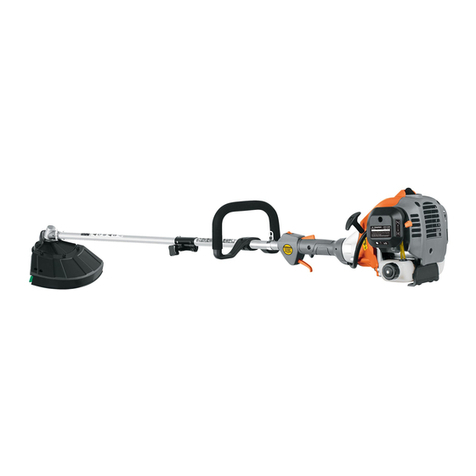
Truper
Truper DES-30R User manual

Truper
Truper PRETUL DES-25P User manual
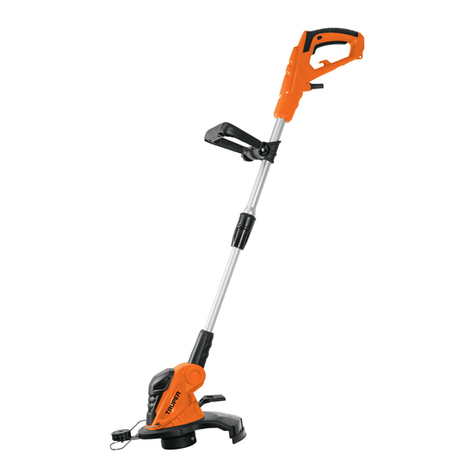
Truper
Truper DES-550 User manual
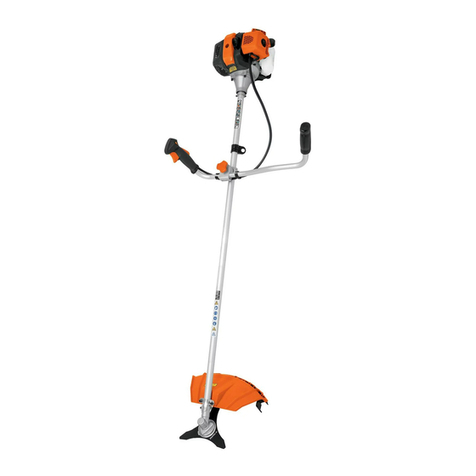
Truper
Truper DES-430 User manual
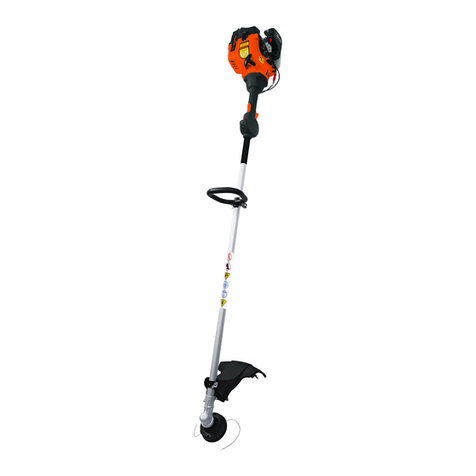
Truper
Truper DES-25R User manual

Truper
Truper DES-26C User manual
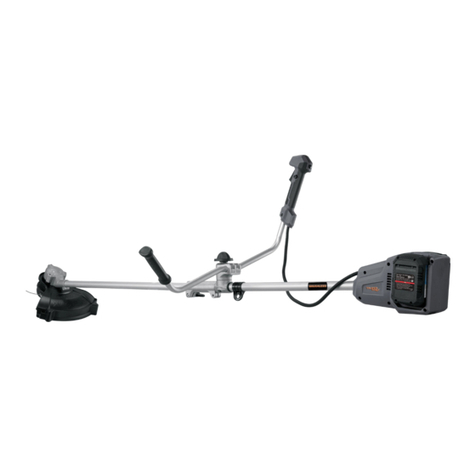
Truper
Truper MAX-40D User manual
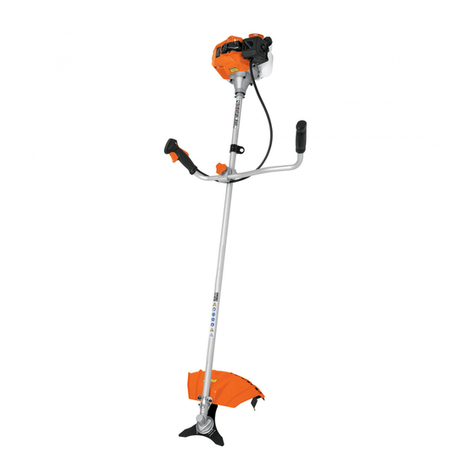
Truper
Truper DES-330 User manual
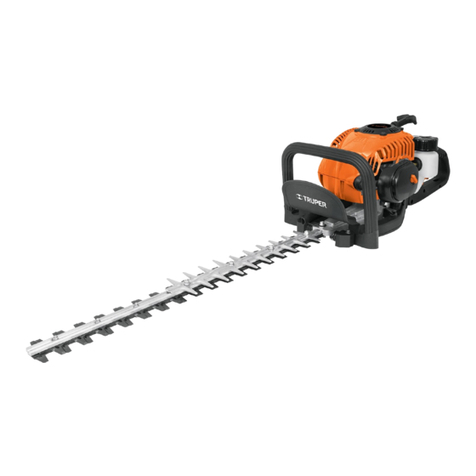
Truper
Truper COS-26X User manual
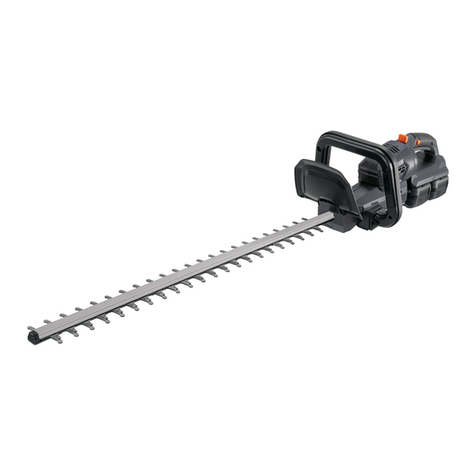
Truper
Truper MAX-40C User manual
Popular Trimmer manuals by other brands

Homelite
Homelite F3045 user manual
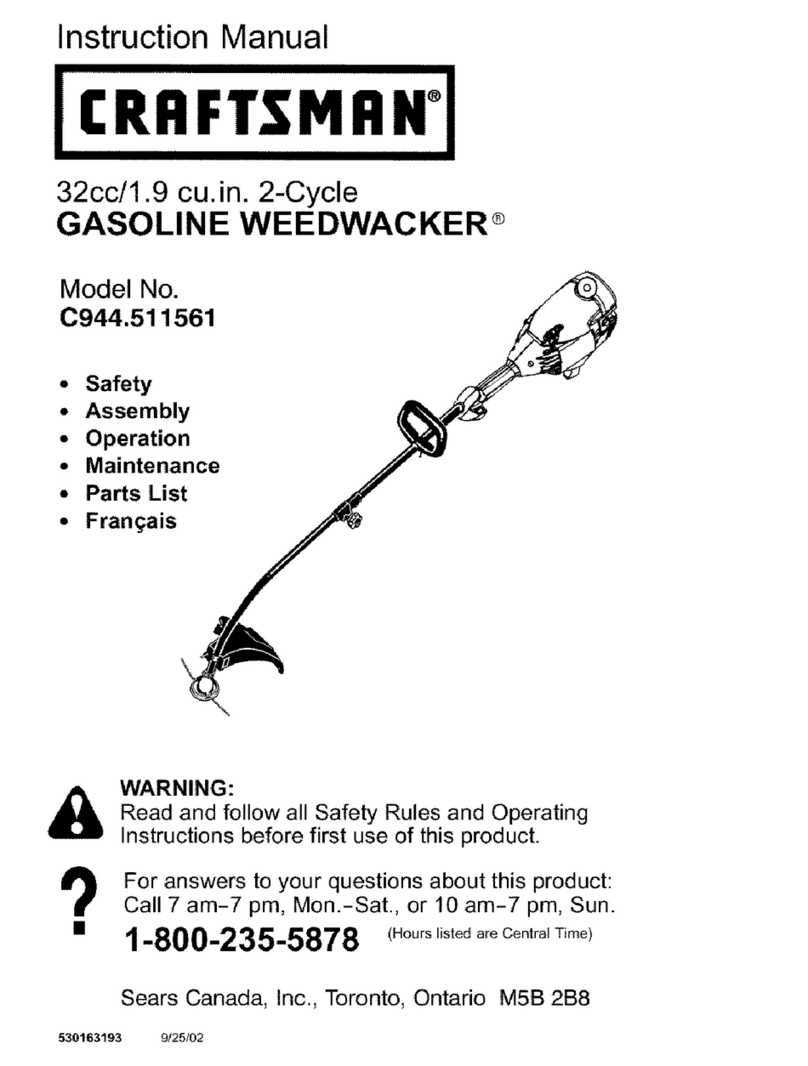
Craftsman
Craftsman WEEDWACKER C944.511561 instruction manual
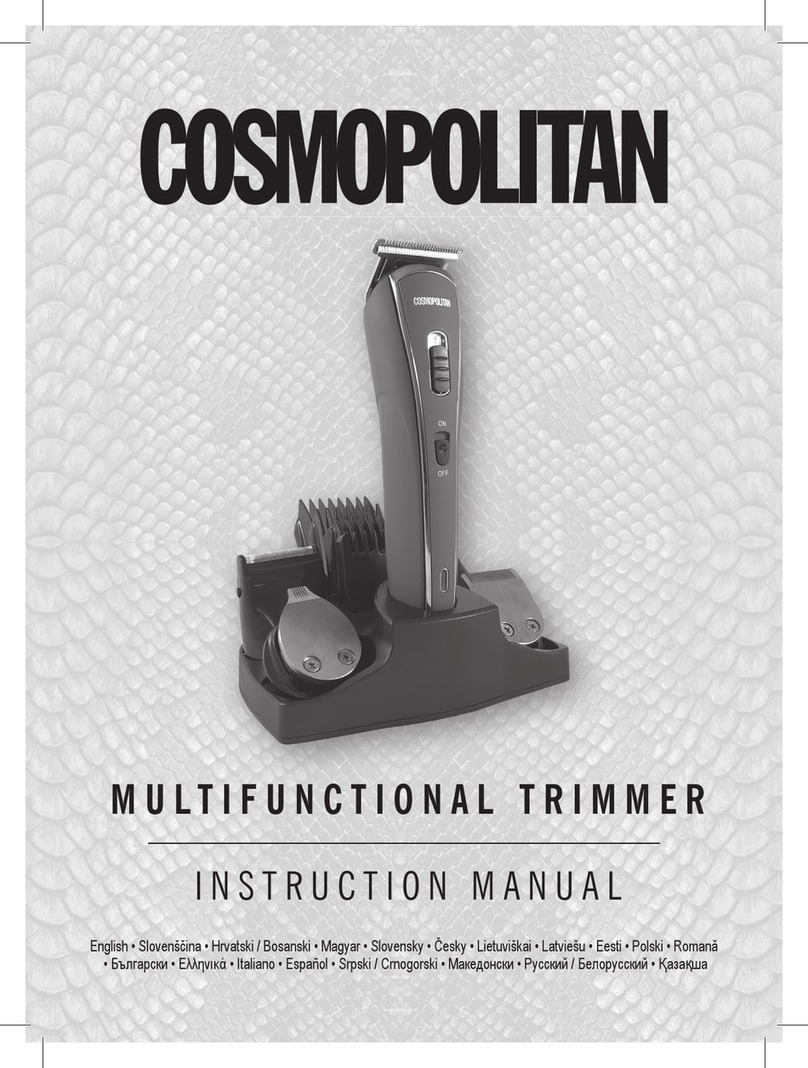
Cosmopolitan
Cosmopolitan KLR928981478 instruction manual
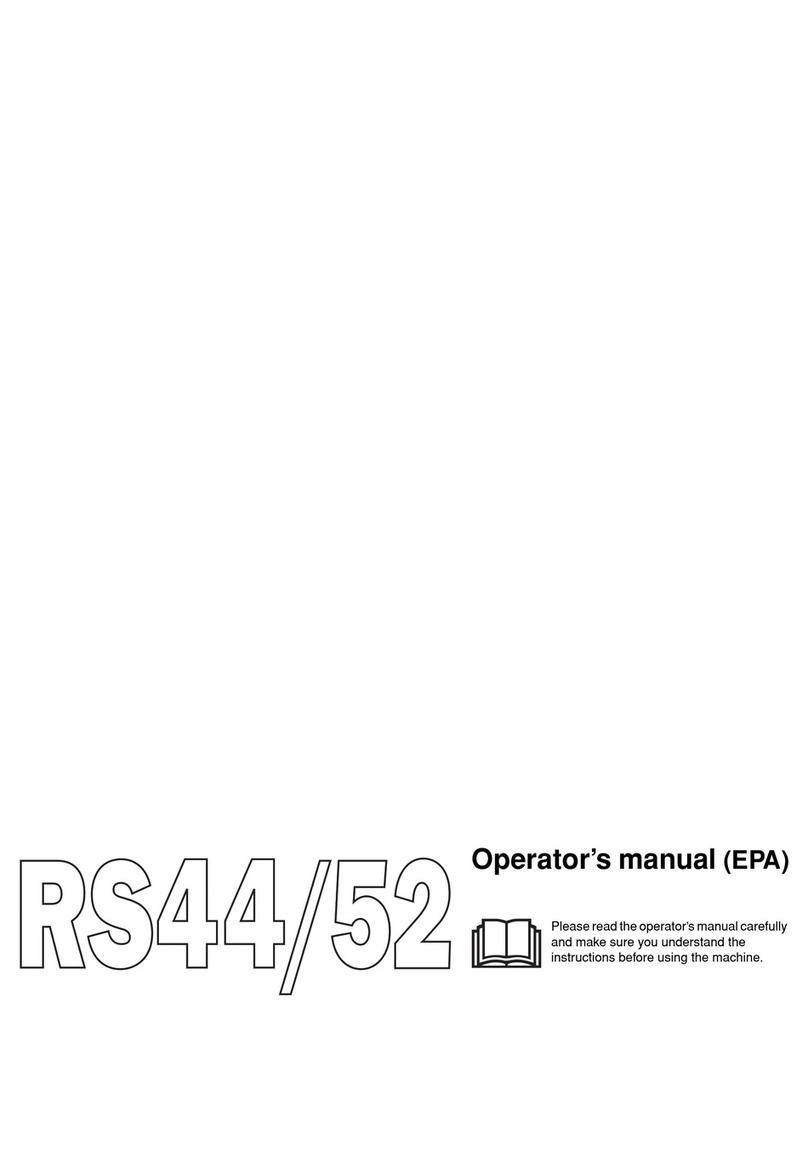
Jonsered
Jonsered RS44/52 Operator's manual

Black & Decker
Black & Decker TRl16 instruction manual
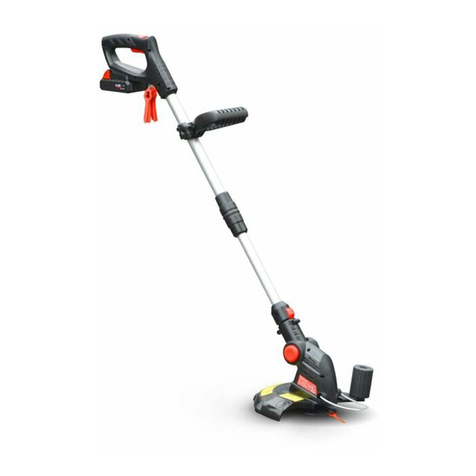
Elem Garden Technic
Elem Garden Technic CBE20VLI25T Original instructions
